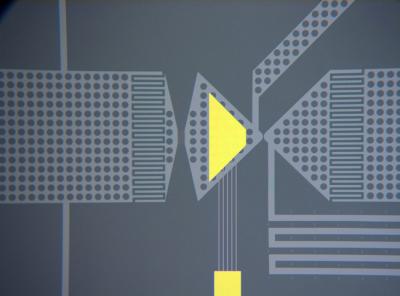Home > Press > New instrument keeps an 'eye' on nanoparticles
 |
| This is an optical microscope image of the microfluidic channel (light pattern) and sensing electrode (gold) of the analyzer. Nanoparticles are suspended in a fluid flow through the channel, and are detected individually as they pass through the sensing volume.
Credit: J.L. Fraikin and A.N. Cleland, UCSB |
Abstract:
Precision measurement in the world of nanoparticles has now become a possibility, thanks to scientists at UC Santa Barbara.
The UCSB research team has developed a new instrument capable of detecting individual nanoparticles with diameters as small as a few tens of nanometers. The study will be published on line this week by Nature Nanotechnology, and appear in the April print issue of the journal.
New instrument keeps an 'eye' on nanoparticles
Santa Barbara | Posted on March 6th, 2011"This device opens up a wide range of potential applications in nanoparticle analysis," said Jean-Luc Fraikin, the lead author on the study. "Applications in water analysis, pharmaceutical development, and other biomedical areas are likely to be developed using this new technology." The instrument was developed in the lab of Andrew Cleland, professor of physics at UCSB, in collaboration with the group of Erkki Ruoslahti, Distinguished Professor, Sanford-Burnham Medical Research Institute at UCSB.
Fraikin is presently a postdoctoral associate in the Marth Lab at the Sanford-Burnham Medical Research Institute's Center for Nanomedicine, and in the Soh Lab in the Department of Mechanical Engineering at UC Santa Barbara.
The device detects the tiny particles, suspended in fluid, as they flow one by one through the instrument at rates estimated to be as high as half a million particles per second. Fraikin compares the device to a nanoscale turnstile, which can count -- and measure -- particles as they pass individually through the electronic "eye" of the instrument.
The instrument measures the volume of each nanoparticle, allowing for very rapid and precise size analysis of complex mixtures. Additionally, the researchers showed that the instrument could detect bacterial virus particles, both in saline solution as well as in mouse blood plasma.
In this study, the researchers further discovered a surprisingly high concentration of nanoparticles present in the native blood plasma. These particles exhibited an intriguing size distribution, with particle concentration increasing as the diameter fell to an order of 30 to 40 nanometers, an as-yet unexplained result.
####
For more information, please click here
Contacts:
Gail Gallessich
805-893-7220
Copyright © University of California - Santa Barbara
If you have a comment, please Contact us.Issuers of news releases, not 7th Wave, Inc. or Nanotechnology Now, are solely responsible for the accuracy of the content.
| Related News Press |
News and information
![]() Researchers develop molecular qubits that communicate at telecom frequencies October 3rd, 2025
Researchers develop molecular qubits that communicate at telecom frequencies October 3rd, 2025
![]() Next-generation quantum communication October 3rd, 2025
Next-generation quantum communication October 3rd, 2025
![]() "Nanoreactor" cage uses visible light for catalytic and ultra-selective cross-cycloadditions October 3rd, 2025
"Nanoreactor" cage uses visible light for catalytic and ultra-selective cross-cycloadditions October 3rd, 2025
Imaging
![]() ICFO researchers overcome long-standing bottleneck in single photon detection with twisted 2D materials August 8th, 2025
ICFO researchers overcome long-standing bottleneck in single photon detection with twisted 2D materials August 8th, 2025
![]() Simple algorithm paired with standard imaging tool could predict failure in lithium metal batteries August 8th, 2025
Simple algorithm paired with standard imaging tool could predict failure in lithium metal batteries August 8th, 2025
![]() First real-time observation of two-dimensional melting process: Researchers at Mainz University unveil new insights into magnetic vortex structures August 8th, 2025
First real-time observation of two-dimensional melting process: Researchers at Mainz University unveil new insights into magnetic vortex structures August 8th, 2025
![]() New imaging approach transforms study of bacterial biofilms August 8th, 2025
New imaging approach transforms study of bacterial biofilms August 8th, 2025
Discoveries
![]() Researchers develop molecular qubits that communicate at telecom frequencies October 3rd, 2025
Researchers develop molecular qubits that communicate at telecom frequencies October 3rd, 2025
![]() Next-generation quantum communication October 3rd, 2025
Next-generation quantum communication October 3rd, 2025
![]() "Nanoreactor" cage uses visible light for catalytic and ultra-selective cross-cycloadditions October 3rd, 2025
"Nanoreactor" cage uses visible light for catalytic and ultra-selective cross-cycloadditions October 3rd, 2025
Announcements
![]() Rice membrane extracts lithium from brines with greater speed, less waste October 3rd, 2025
Rice membrane extracts lithium from brines with greater speed, less waste October 3rd, 2025
![]() Researchers develop molecular qubits that communicate at telecom frequencies October 3rd, 2025
Researchers develop molecular qubits that communicate at telecom frequencies October 3rd, 2025
![]() Next-generation quantum communication October 3rd, 2025
Next-generation quantum communication October 3rd, 2025
![]() "Nanoreactor" cage uses visible light for catalytic and ultra-selective cross-cycloadditions October 3rd, 2025
"Nanoreactor" cage uses visible light for catalytic and ultra-selective cross-cycloadditions October 3rd, 2025
Tools
![]() Japan launches fully domestically produced quantum computer: Expo visitors to experience quantum computing firsthand August 8th, 2025
Japan launches fully domestically produced quantum computer: Expo visitors to experience quantum computing firsthand August 8th, 2025
![]() Rice researchers harness gravity to create low-cost device for rapid cell analysis February 28th, 2025
Rice researchers harness gravity to create low-cost device for rapid cell analysis February 28th, 2025
|
|
||
|
|
||
| The latest news from around the world, FREE | ||
|
|
||
|
|
||
| Premium Products | ||
|
|
||
|
Only the news you want to read!
Learn More |
||
|
|
||
|
Full-service, expert consulting
Learn More |
||
|
|
||








